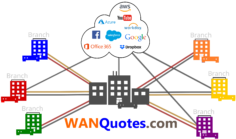A software-defined wide area network (SD-WAN) is a wide area network that uses software-defined network technology, such as communicating over the Internet using overlay tunnels which are encrypted when destined for internal organization locations. If standard tunnel setup and configuration messages are supported by all of the network hardware vendors, SD-WAN simplifies the management and operation of a WAN by decoupling the networking hardware from its control mechanism. This concept is similar to how software-defined networking implements virtualization technology to improve data center management and operation. In practice, proprietary protocols are used to set up and manage an SD-WAN, meaning there is no decoupling of the hardware and its control mechanism.
A key application of SD-WAN is to allow companies to build higher-performance WANs using lower-cost and commercially available Internet access, enabling businesses to partially or wholly replace more expensive private WAN connection technologies such as MPLS.
At the same time, the perimeter of the cloud-native enterprise is much more fluid than that of the WANs of the past, meaning that modern-day business infrastructure is often too complex and multifaceted to manage and support efficiently with traditional “hub-and-spoke” solutions. Fortunately, software-defined WAN (SD-WAN) technology has burst on the scene, offering today’s digital enterprises a compelling way forward. SD-WAN utilizes bandwidth more efficiently and economically, optimizing the WAN infrastructure to lower costs while increasing application and network reliability and performance. Adoption is ramping up: 360iResearch expects the global market to grow from $843 million in revenue last year to $15 billion by the end of 2024, at a whopping CAGR of 51 percent. In a recent Frost & Sullivan SD-WAN report, market revenue in North America alone exceeded $300 million in 2017. About 7 percent of enterprise IT decision-makers said they have deployed SD-WAN; and about a quarter (23 percent) of them said they plan to deploy SD-WAN in the next 12 to 24 months



